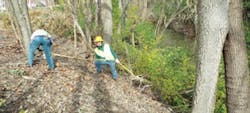Veg Out
Mill Creek flows 28 miles from its headwaters in southeastern Butler County, Ohio, through Hamilton County, Ohio, to its confluence with the Ohio River in the heart of Cincinnati. It has historically been known for a number of ecological challenges, including systemic streambank erosion, flooding, impaired water quality, lack of aquatic and terrestrial habitat diversity, poor riparian cover and an abundance of invasive species, such as bush honeysuckle, garlic mustard and winter creeper.
In response to these ecological challenges, the city of Wyoming sought and was awarded a grant from the Clean Ohio Green Space Conservation Program to address impairments along West Fork Creek, a 9.5-mile tributary to Mill Creek that flows through the city of Wyoming, an established tree-lined community of 8,500 residents centrally located in the greater Cincinnati metropolitan area.
The West Fork Mill Creek Riparian Restoration Project aims to improve riparian cover, terrestrial and aquatic habitat, and water quality by removing invasive plant species and restoring the riparian corridor along Mill Creek. This will be achieved by planting native riparian-appropriate plant species along approximately 4,500 ft of the creek, equating nearly 5 acres of restoration. The project addresses various sources of impairment by restoring a naturally functioning riparian corridor, which can intercept urban storm water runoff, reduce sediment pollution and nutrient transport, and support a functional stream ecosystem. When complete, the project will bring this reach of West Fork Mill Creek closer to attainment of Ohio’s Aquatic Life Use Standards.
The Project Begins
In November 2013, Wyoming began removal of invasive plant species within the project area. Invasive plants are problematic in Ohio and throughout the U.S., as they displace native plants and animals, decrease biodiversity, and have been identified as the second leading cause of animal population decline and extinction worldwide. Locally, the dominance of invasive plants along the riparian corridor of the creek has inhibited natural regeneration of native trees, shrubs and perennial wildflowers, compromising the aesthetics, habitat value and ecological function of the corridor.
Invasive plant eradication efforts included chemical and mechanical removal of invasive plant species, followed by clearing of remaining stumps and biomass. Herbicide consisted of a glyphosate solution mixed with dye to allow visual assessment of treated and untreated plants.
Target species of woody trees and shrubs included tree of heaven (Ailanthus altissima) and amur (Lonicera maackii), morrow (Lonicera morrowii) and tatarian (Lonicera tatarica) bush honeysuckles. Woody target species were eradicated with a cut-stump application method, a combined method of mechanical removal of woody vegetation followed by a direct application of herbicide to freshly cut stems or stumps. Target herbaceous species included garlic mustard (Alliaria petiolata), winter creeper (Euonymus fortunei), periwinkle (Vinca minor), and English ivy (Hedera helix). Herbaceous target species were eradicated with a foliar application
of herbicide.
The Future
The harvested biomass of targeted trees and shrubs, in the forms of brush, logs and stumps, were placed through a wood chipper and transported to local composting operations. Following removal of biomass, the project area was seeded with a low stature native prairie mix. The seedbed was prepared by scarifying the soil surface. A hand-broadcasting method was used to apply the seed, accompanied by raking and rolling to ensure good soil-to-seed contact. Straw mulch then was applied at a rate of approximately 1.5 tons per acre.
Riparian buffer restoration—the installation of native trees and shrubs—will occur in spring 2014. Reestablishing native riparian plant communities supports wildlife habitat and improves water quality through absorption and retention of nonpoint source pollutants. Pollutants infiltrate into the root matrix (bioactive rhizosphere) and settle out prior to reaching a neighboring water body or receiving stream. Additional benefits of riparian buffers include: support of stream stability by providing mechanical reinforcement of streambank soils; improvement of aquatic habitat by encouraging canopy cover to moderate water temperature and increase dissolved oxygen; and prevention of property loss from erosive stream forces.
An informed planting design will establish the optimum combinations of native floristic communities to provide an ecologically functional nonpoint source pollutant attenuation system, while replenishing the historic character through selection of native plant species and planting at natural densities. Trees and shrubs will be installed as community groupings to emulate a natural forest stand. Protective herbivory techniques, such as tree tubes and deer fence, also are being considered to shield the plantings from browse and rub damage by white-tailed deer. Species selection will be dependent on nursery availability.
Download: Here


